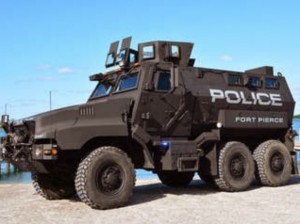| Online: | |
| Visits: | |
| Stories: |
The Feds Are Also Militarizing Public Schools With Grenade Launchers, M16s & Tanks
Thursday, September 18, 2014 9:02
% of readers think this story is Fact. Add your two cents.
Events last month in Ferguson, Missouri (read my detailed thoughts here) forced Americans to confront the frightening reality that many of of the nation’s police departments have been quietly, but consistently, militarizing over the past couple of decades. It’s one thing to intellectually understand that this has happened, it’s quite another to see cops deploy tanks and point sniper rifles at peacefully protesting U.S. citizens.
Just as disturbing as the scenes themselves, is the fact that this has been happening for so long under the 1033 transfer program with only muted criticism. The program was originated in the late 1990′s under the National Defense Authorization Act of 1997 (recall that the NDAA is also being used to allow for the indefinite detention of American citizens without trial), and it allows for the transfer of excess Department of Defense equipment to domestic police. In other words, it has been public policy for almost two decades to militarize the police.
With the issue squarely still in the public consciousness, it would behoove us to understand that this program is not only arming police with weapons of war. In fact, public schools are also receiving such items, including grenade launchers, M16s and MRAPs.
The Wall Street Journal reports that:
A federal program that has drawn criticism in recent weeks for supplying surplus military gear to local police has also provided high-powered rifles, armored vehicles and other equipment to police at public schools, some of whom were unprepared for what they were getting.In the wake of school shootings in Newtown, Conn., and elsewhere, some school security departments developed SWAT teams, added weapons and called on the federal government to help supply gear. But now, the program is facing renewed scrutiny from both outside observers and schools using it.The Los Angeles Unified School District stocked up on grenade launchers, M16 rifles and even a multi-ton armored vehicle from the program. But the district is getting rid of the grenade launchers, which it never intended to use to launch grenades or use in a school setting, said Steven Zipperman, chief of the Los Angeles Schools Police Department. The launchers, received in 2001, might have helped other police in the county disperse crowds by shooting rubber munitions, he said.In July, the district received a massive MRAP armored vehicle. Mr. Zipperman said his department thought it could be useful for evacuations and to save lives in a “sustained incident.”
Just in case you aren’t aware, this is an MRAP:

Makes you wonder how schools survived in America for over two hundred years without tanks. More from the WSJ…
In Texas, near the Mexican border, the sprawling Edinburg Consolidated Independent School District has 34,700 students and operates its own SWAT team, thanks in part to military gear it received in recent years from the federal program. The gear included two Humvees and a cargo truck, as well as power generators, said district Police Chief Ricardo Perez. The district applied for weapons, too, but wasn’t given any, so instead purchased its own M4 and AR-15 assault-style rifles, he said.The weapons are given to schools through the 1033 Program, created by Congress in the early 1990s to allow law-enforcement agencies to obtain excess Defense Department supplies, paying only for shipping. The program has transferred $5.1 billion in items, including $4.5 million worth in 2013.Among recipients are more than a dozen school police departments, according to a spreadsheet from the Defense Logistics Agency, which runs the program. But for security reasons the list excludes districts that received only “tactical” gear such as weapons, as opposed to other types of supplies. That means the list likely understates the number of districts that participated.California is one of few states that provides a list of participating school districts and what they received. Its state website shows that two school police departments received armored vehicles, others added M-16s and grenade launchers to their armories, while one district took in televisions, projectors and a podium but no weapons.
What I find most interesting about all of this, is where have all the “gun control” politicians and hysterics been on the dangers of the 1033 for all these years?
Indeed, while politicians in D.C. appear determined to invade half the countries on earth, while simultaneously arming the other half, from terrorist groups in the Middle East to police departments and school districts domestically, it appears the only group being singled out for disarmament is the citizenry itself. Makes you wonder doesn’t it…
For more thoughts on the matter read: How to Spot a Hypocrite in the Gun Debate and Other Reflections on Newtown.
Credit to Zero Hedge
Source: http://nunezreport.blogspot.com/2014/09/the-feds-are-also-militarizing-public.html




